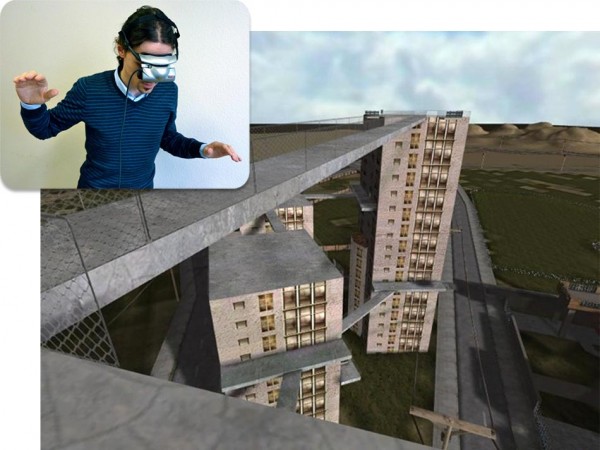Computers and Therapy
Ever since ELIZA was developed to simulate a psychotherapist in 1966, computers have been used in a widely within clinical psychology and therapy. This page contains a brief overview of some ways that technology is being used to enhance and disseminate mental health interventions.
Jump to:
- Internet-supported interventions
- Computerized therapy
- Therapeutic robots
- Virtual Reality therapy
- Video game therapy
Internet-supported interventions
Web-based therapy
Related terms: Online therapy, e-Therapy, online counselling, teletherapy, telepsychiatry

The internet can be used as a means of communication between a mental health practitioner and a patient. This may be used as an alternative to traditional face-to-face sessions, or offered as a supplementary service. Psychotherapy can be conducted via:
- video conferencing (e.g. Skype)
- instant messaging
- online forums (e.g. for group therapy)
The primary advantage of web-based treatments is that they eliminate the need for the therapist and patient to be located in the same room (or even the same country). Given the following recent advances:
- an increase in internet speed and accessibility
- a decrease in hardware costs
- improvements in teleconferencing software
one might expect this to be a popular treatment method. However, online therapy has not yet seen widespread adoption. One reason is that online treatment from a qualified professional costs about the same as face-to-face therapy (the demand on the therapist's time remains high). Without significant savings, and all else being equal, the majority of people prefer to attend talk therapy in person.
Self-guided treatments
Related terms: online self-help
Before the internet, self-help programs were distributed as books, videos, or audio series. All of this content can be easily adapted for websites, and enhanced with multimedia content, user interaction, quizzes, etc. This is an efficient and cost effective means of publishing self-help material.
There are thousands of self-help systems available online. The quality of these programs varies widely, from cutting-edge interventions from leading researchers, to baseless (or even harmful) advice from self-proclaimed gurus.
Therapist assisted online self-help
Some online systems combine self-help and interaction with a live therapist. For example, a user may work through some content independently, and a therapist periodically reviews their progress and answers any questions they may have.
Computerized therapy

Related terms: Computerized CBT, AI therapy
Computerized therapy uses software to administer dynamic mental health interventions with no (or limited) therapist involvement. This is related to internet-supported treatments, in that both involve the use of a computer. However, the key distinction is that online therapy uses the computer as a means of delivery, whereas the computer plays a more active role in computerized therapy. For example, encoded logic (algorithms) can automatically formulate an individualized treatment plan for each user.
Computerized therapy programs can be made available over the internet, but this is not a requirement. Systems may be made available through smartphone apps, standalone software programs, or even be embedded in special purpose computers, such as robots.
Cognitive behavioral therapy (CBT) is well suited for computerization, as the treatment strategy follows a well defined and formal methodology (see here). However, forms of therapy that rely more heavily on verbal interaction and the patient-therapist relationship are not yet possible. Future systems may use sophisticated Artifical Intelligence (AI) technology to bridge the gap between computerized and live therapy.
AI-Therapy's Overcome Social Anxiety treatment program is an example of computerized therapy, as the clinical content is adapted to the needs of the user without therapist involvement (see here for more information).
Therapeutic robots
Related terms: robotic companions, robot therapy
People are social animals, and we benefit greatly from the companionship of others. Companionship is so central to the human condition that we often form strong bonds with non-human counterparts. For example, people have been forging deep friendship with their pets for millennia, and there is evidence that animals can play a positive role in mental wellbeing. Unfortunately, many people, such as those suffering from degenerative diseases such as Alzheimer's or other forms of dementia, are unable to care for an animal. In these cases robots can fill an important void in their lives.

An example of a robotic companion is Paro (see picture), which looks like a baby seal. The seal can respond to sound and touch, shows different emotions, has sleep patterns, and is able to learn information about its environment, such as the name of its carer.
Robots can also be a helpful tool for those with autism. People with autism have trouble with social interaction. However, they often have a fondness for computers and technology, so robots can be a helpful tool for teaching social skills. Similarly, robots are being researched as a learning aid for children with anxiety or mood disorders.
More generally, robots can provide much needed companionship for the lonely and socially isolated. The Japanese space agency is investigating the use of robots to keep astronauts company during extended space missions.
Virtual Reality Therapy
Related terms: virtual reality immersion therapy, simulation for therapy, virtual reality exposure therapy

Virtual reality (VR) places people in a simulated and imaginary environment, typically through the use of a stereoscopic headset. VR has the advantage that the system designers have complete control over what the user sees and hears. Therefore, VR can be used to help diagnose and treat mental health problems. The most common application is exposure therapy for the treatment of an anxiety disorder or a specific phobia. For example, a patient can be exposed to an object (spider, dirty toilet seat, etc.) or situation (heights, flying, etc.) in a safe and controlled environment. Meanwhile, a therapist can closely monitor the patient's emotional and physiological reactions. Once a patient is comfortable with a virtual simulation of their phobia, they can progress to exposure in real-world situations.
Virtual reality is also being used as a tool to help treat PTSD. For example, many soldiers experience traumatic events while in combat, resulting in a range of debilitating symptoms. Using VR soldiers are able to relive and confront past events, while learning coping strategies from a therapist in real time.
Video game therapy

Related terms: therapeutic video games
Video games that promote physical health, such as Nintento's Wii Fit, are becoming a popular form of exercise. It is well known that being physically fit and active has a positive impact on mood and happiness, so these games have some follow-on benefits for mental health. Recently, some games have been developed that directly target psychological issues.
SPARX is a video game designed to target depression and anxiety in teenagers. The game takes place in a fantasy world. As the user navigates the environment they complete various tasks and challenges which are designed to teach them techniques for dealing with depression. For example, the user learns ways to challenge their negative thoughts.